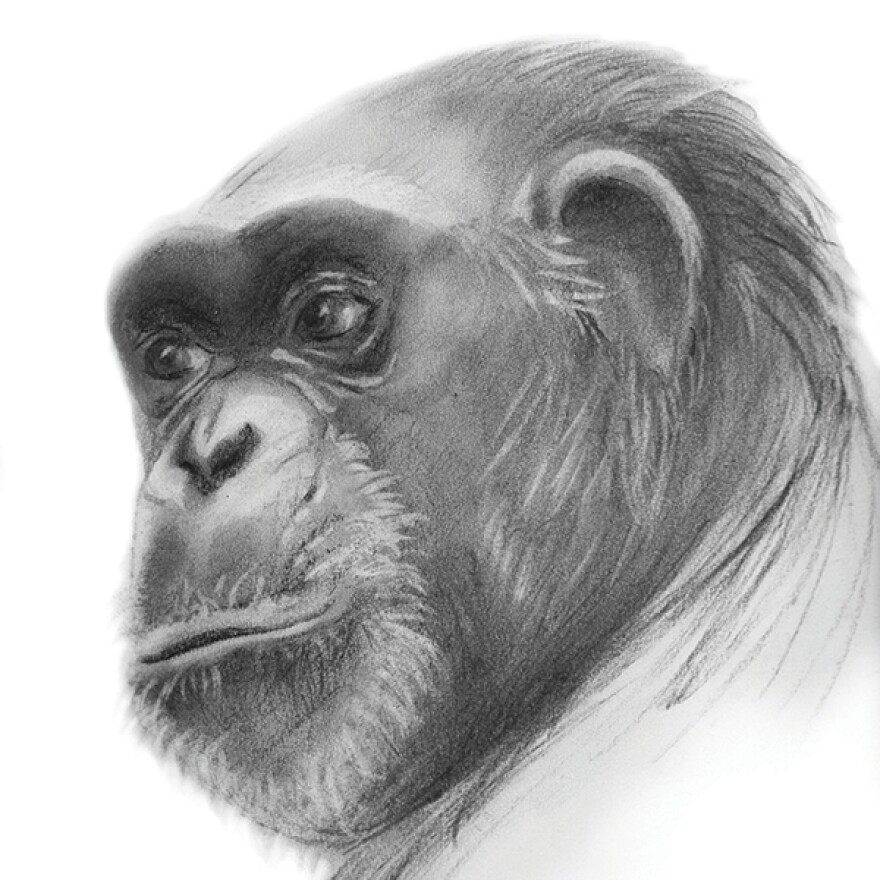Chimpanzees have been bred for research here since the 1950s, and at one point, the state was home to the largest captive chimpanzee colony on the planet. But the National Institutes of Health decided to stop funding chimp research last month. The move marks a sea change in biomedical ethics—and might prove smarter for human health.
It was a chilly December morning, but that didn't stop people from crowding around the giant windows of the chimpanzee habitat at the Rio Grande Zoo.
Chimp twins were born this year. One hung by a single arm and swung back and forth, lightly striking the viewing window with an open palm. It was as if the little ape was trying to high-five the audience. Zoo Manager Lynn Tupa said they are lot like humans. "Because you’ll see them, they get jealous," she said. "They get angry. They will try to manipulate each other, or they make alliances with each other. It’s very human-like."
Tupa said they’re a great group though, despite all they’ve been through. The zoo acquired 10 adults from a federally funded breeding and research facility in Southern New Mexico, and even though they weren’t used in experiments, it took a while for them to build up trust. "So they were very wary of a lot of things," she said. "Like Alf the big male, he would only take fruit if it was completely whole, because I think they would probably hide medicine in fruit cut up."

The Air Force first brought infant chimps from West Africa to New Mexico in the ‘50s. The Alamogordo facility was established decades later. The population grew to more than 600 and was used for studying AIDS and Hepatitis C.
Back then, primate testing was the norm. Dr. John Gluck, who built the University of New Mexico’s primate lab in 1971, remembered one monkey fondly. "I’ll never forget her number," he said. "And she was extremely smart." They called her H-89, and she was a stump-tailed macaque.
"It was as if she had a competition with me to find a non-acceptable way to solve the problems and get rewards without doing it the way I wanted them to do it," he said.
Gluck realized that he’d developed an emotional attachment to H-89. "I enjoyed working with her, and I was always excited to see how she would figure things out that I didn’t expect."
He had gotten grant funding to study the effects of drug abuse on learning and retention, and of environment on brain development. But what about the lab setting itself—captivity—did that affect the studies? "I guess in a way I’m almost embarrassed to say it took a while for me to appreciate that," he said. "I grew up as it were, educationally, with animals in labs. We more or less thought of those laboratory environments as relatively neutral."
He began to question: What are the limits to the pain and suffering you could cause in animals in the interest of benefiting human health? Gluck’s now a research professor at the Kennedy Institute of Ethics at Georgetown, and his position today is that animals should continue to be used in research, but the bar should be much higher when determining whether it’s necessary. "It’s not an all-or-nothing position," he said. "Not just: Is something a good idea scientifically? That’s definitely necessary in justification, but it’s not sufficient by itself."

Gluck said the NIH’s November announcement that it would no longer fund chimpanzee research is a massive shift. Both the NIH and what’s now known as the Alamogordo Primate Facility refused to comment for this story. The facility lost its accreditation under prior management and had to halt invasive testing in 2001.
And then in 2010, the NIH decided it wanted to use the chimps for research once again. But objections were loud from around the state. So the NIH commissioned the first objective study on the need for chimp testing. The results? It’s not necessary in a lot of cases. It’s also pretty expensive. Taxpayers were shelling out millions for chimp research every year.
Laura Bonar of Animal Protection New Mexico said animal research has been driven by money, by grants being renewed for projects year after year without their effectiveness called into question or other options being explored. "All of that funding now is not going to be spent on that kind of research anymore, that we now recognize as ineffective," she said.
Now, she said, that funding can be better spent. "Of course we have limited resources. And I’m sure everyone who cares about people’s health, we want to be spending those dollars wisely."
And what about the rest of the chimps the federal government owns? All of them will be going to sanctuaries.



